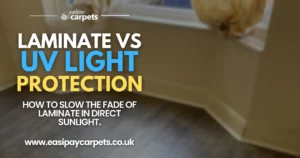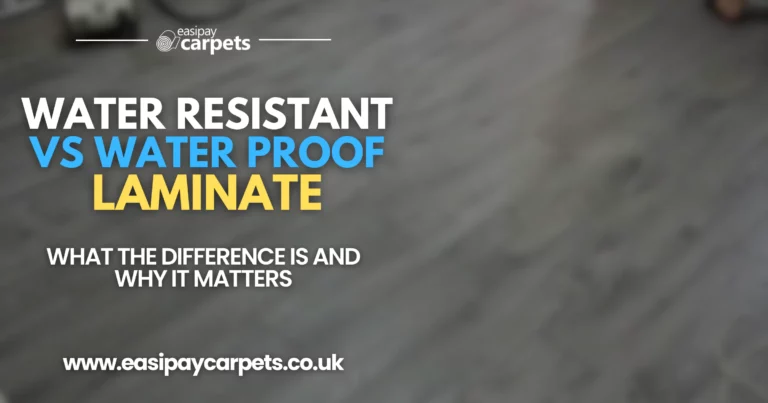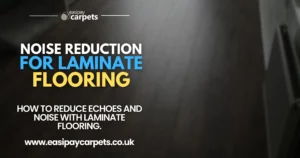

Water-Resistant vs. Waterproof Laminate – Which One Do You Need?
The Difference Between Water-Resistant and Waterproof Laminate Flooring
Laminate flooring has come a long way in terms of durability, but if you’re looking for a floor that can handle spills, moisture, and damp conditions, you’ll need to decide between water-resistant and waterproof laminate.
While the terms may sound similar, they refer to very different levels of protection against moisture and water damage. Understanding these differences will help you make the right choice for your home.
What is Water-Resistant Laminate?
Water-resistant laminate flooring is designed to withstand small amounts of moisture for a limited period. It has a protective surface layer that repels spills and splashes, but water can still seep into the core if left for too long.
How Water-Resistant Laminate Works
- The top layer has a water-repellent coating that slows down moisture absorption.
- The core is still made of high-density fibreboard (HDF), which can swell if water seeps in.
- Water-resistant laminate buys you time to clean up spills before damage occurs.
✔ Best for: Living rooms, bedrooms, hallways, and areas where spills are occasional.
🚫 Not ideal for: Bathrooms, wet rooms, or areas with high humidity.
What is Waterproof Laminate?
Waterproof laminate is fully protected against water damage, meaning spills won’t penetrate the flooring, even if left for an extended period.
How Waterproof Laminate Works
- The top layer has an advanced waterproof sealant that blocks moisture.
- The core layer is made from waterproof materials, such as PVC or a treated composite that won’t swell when exposed to water.
- The edges are sealed to prevent water from seeping between planks.
✔ Best for: Kitchens, bathrooms, laundry rooms, basements, and high-moisture areas.
🚫 Not ideal for: Budget-conscious homeowners (as waterproof laminate tends to be more expensive).
Key Differences Between Water-Resistant & Waterproof Laminate
| Feature | Water-Resistant Laminate | Waterproof Laminate |
|---|---|---|
| Protection Level | Resists spills for a limited time | Fully waterproof, even if left wet |
| Core Material | HDF (High-Density Fibreboard) | Waterproof composite or PVC |
| Top Layer | Water-repellent coating | Waterproof sealant |
| Seams & Joints | Standard, may allow water through | Sealed to block water infiltration |
| Maintenance | Needs spills cleaned quickly | Can handle standing water |
| Best For | Living rooms, hallways, dry areas | Bathrooms, kitchens, basements |
| Cost | More affordable | More expensive |
Pros and Cons of Water-Resistant Laminate
Pros:
✔ More affordable than waterproof laminate.
✔ Looks and feels like traditional laminate flooring.
✔ Protects against everyday spills if cleaned up quickly.
✔ Easier to install than waterproof options.
Cons:
- Can be damaged by prolonged exposure to water.
- Not suitable for humid or wet areas like bathrooms.
- Requires immediate clean-up of spills to avoid warping.
Pros and Cons of Waterproof Laminate
Pros:
✔ 100% waterproof, even in humid or wet areas.
✔ Ideal for kitchens, bathrooms, and basements.
✔ More durable and resistant to swelling or warping.
✔ Often has tighter locking systems to prevent leaks.
Cons:
- More expensive than standard or water-resistant laminate.
- Some styles may be harder to install due to the sealed joints.
- Limited variety compared to traditional laminate options.
Which One Should You Choose?
Choose Water-Resistant Laminate If:
✔ You need a budget-friendly flooring option.
✔ Your home has low to moderate moisture exposure.
✔ You’re installing flooring in living rooms, bedrooms, or hallways.
✔ You don’t mind quickly wiping up spills to prevent damage.
Choose Waterproof Laminate If:
✔ You want maximum protection against moisture and spills.
✔ You’re installing flooring in bathrooms, kitchens, or basements.
✔ You need a long-lasting, durable flooring solution.
✔ You want a low-maintenance floor that won’t warp over time.
How to Protect Any Laminate Flooring from Water Damage
Even if you choose water-resistant or waterproof laminate, you should still take steps to prevent moisture-related issues.
✔ Use mats or rugs in high-risk areas, such as near sinks and entryways.
✔ Clean up spills immediately, even on waterproof flooring.
✔ Apply a water-resistant sealant to seams for extra protection.
✔ Avoid using excessive water when mopping—use a damp mop instead.
✔ Ensure proper ventilation in humid rooms to reduce moisture build-up.
Conclusion
Both water-resistant and waterproof laminate flooring offer moisture protection, but the right choice depends on your needs.
- If you want basic spill resistance in dry areas, water-resistant laminate is a cost-effective option.
- If you need full water protection for kitchens, bathrooms, or basements, waterproof laminate is worth the investment.
By understanding the key differences, you can confidently choose the best laminate flooring for your home while ensuring long-term durability.
Are you on the hunt for new flooring? With Easipay Carpets you can get the flooring of your dreams from as little as £10 per week, completely interest free! We offer Carpets, Vinyl and Laminate flooring with free underlay, door bars, carpet grippers and beading wherever needed on payment plans that spread the cost of the flooring into smaller, more manageable payments. Find out more at the button below!
Still Got Questions? Here's 10 FAQs!
It can resist spills for 30 minutes to a few hours, but leaving liquid on it too long may cause damage.
Yes, it is designed to handle standing water without absorbing moisture. However, prolonged exposure to excessive water may still cause issues over time.
It’s not recommended. Instead, choose waterproof laminate or vinyl flooring for full moisture protection.
No, both types have a similar look and feel, but waterproof laminate tends to have tighter seams and a more rigid core.
Check the manufacturer’s label—if it’s waterproof, it will clearly state it. Water-resistant laminate will specify limited protection against moisture.
No, steam can still weaken the protective layer over time. Use a damp mop instead.
Yes, waterproof laminate costs more due to its advanced core materials and sealed edges, but it provides better protection.
Yes, it’s an excellent choice for basements as it resists humidity and damp conditions.
No, just regular sweeping and damp mopping to keep it clean. Avoid leaving standing water for long periods.
Yes, you can seal the seams with a water-resistant sealant to improve protection against moisture.




